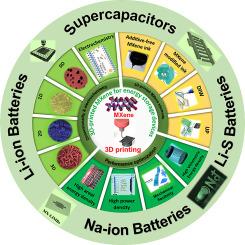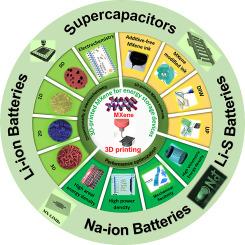三维打印 MXene 电极对储能的影响:可打印 MXene 油墨的不同尺寸、电化学和性能优化
IF 18.9
1区 材料科学
Q1 CHEMISTRY, PHYSICAL
引用次数: 0
摘要
MXene 和三维打印技术是现代能源相关研究的先驱。三维打印(或称增材制造)因其在生产简单原型方面的易用性和快速性而备受青睐。然而,MXenes 与其他二维材料类似,具有团聚倾向,从而限制了电解质的流动和有效表面积的利用。在阳极电位较高的情况下,它们也很容易氧化,从而降低了电极的稳定性。克服这些问题的有效方法是采用 3D 打印技术合理设计和制造基于 MXene 的储能电极,这是一种基于程序的制造方法,可以调节可扩展性、产品设计和可重复性。此外,市场对可打印、可穿戴和可拉伸的储能电子设备需求巨大。在这方面,3D 打印技术在构建高性能储能电极和设备方面显示出令人满意的潜力。在此,我们将重点介绍三维打印技术在构建用于储能应用的先进 MXene 基电极方面的最新进展。此外,还简要介绍了不同二氧化二烯的尺寸和电化学特性。本综述还总结了可打印 MXene 油墨的性能优化,以制造用于超级电容器和二次电池的高效 3D 打印电极。文章还广泛综述了目前可三维打印的基于 MXene 的超级电容器和二次电池电极的应用。最后,本文总结了该领域的未来发展方向和现有研究挑战。本文章由计算机程序翻译,如有差异,请以英文原文为准。


Impact of 3D printed MXene electrodes on energy storage: Different dimensionalities, electrochemistry and performance optimization of printable MXene ink
MXene and 3D printing technology are the pioneers of modern energy-related research. 3D printing, or, additive manufacturing has garnered a lot of devotion because of its ease of use and speed in producing simple prototypes. Nevertheless, MXenes, similar to other 2D materials, show an agglomeration tendency, which restricts electrolyte flow and utilization of the effective surface area. They easily oxidize at high anode potentials also, which additionally lowers the stability of the electrode. An effective way to overcome these problems is to rationally design and create MXene-based electrodes employing 3D printing technology for energy storage, which is a programmed-based manufacturing method that can regulate scalability, product design, and reproducibility. Additionally, there is a huge demand for printable, wearable, and stretchable electronic devices for energy storage. Regarding this, 3D printing technology has shown satisfactory potentiality for constructing high-performance energy storage electrodes and devices. Herein, the recent advancements in 3D printing technologies for constructing advanced MXene-based electrodes for energy storage applications are highlighted. Moreover, the dimensionalities and electrochemistry of different MXenes are emphasized briefly. This review also summarizes the performance optimizations for the printable MXene inks to fabricate efficient 3D-printed electrodes for supercapacitors and secondary batteries. The current application of 3D-printable MXene-based electrodes for supercapacitors and secondary batteries is extensively reviewed. Finally, this article concludes with the future directions and existing research challenges in this field.
求助全文
通过发布文献求助,成功后即可免费获取论文全文。
去求助
来源期刊

Energy Storage Materials
Materials Science-General Materials Science
CiteScore
33.00
自引率
5.90%
发文量
652
审稿时长
27 days
期刊介绍:
Energy Storage Materials is a global interdisciplinary journal dedicated to sharing scientific and technological advancements in materials and devices for advanced energy storage and related energy conversion, such as in metal-O2 batteries. The journal features comprehensive research articles, including full papers and short communications, as well as authoritative feature articles and reviews by leading experts in the field.
Energy Storage Materials covers a wide range of topics, including the synthesis, fabrication, structure, properties, performance, and technological applications of energy storage materials. Additionally, the journal explores strategies, policies, and developments in the field of energy storage materials and devices for sustainable energy.
Published papers are selected based on their scientific and technological significance, their ability to provide valuable new knowledge, and their relevance to the international research community.
 求助内容:
求助内容: 应助结果提醒方式:
应助结果提醒方式:


